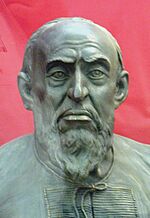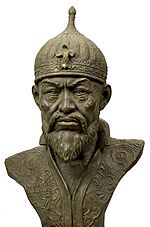Mikhail Gerasimov (archaeologist) facts for kids
Mikhail Mikhaylovich Gerasimov (born September 2, 1907 – died July 21, 1970) was a famous Soviet scientist. He was an archaeologist, who studies old human history, and an anthropologist, who studies human societies and cultures.
Gerasimov became well-known for discovering the Mal'ta–Buret' culture, an ancient group of people. He also created a special way to rebuild faces from old skulls. This method is called forensic sculpture. He used information from anthropology, archaeology, paleontology (the study of fossils), and forensic science (science used in legal cases).
He carefully studied the skulls of over 200 people. Then, he rebuilt their faces. These people ranged from early humans like Homo sapiens and Neanderthals to kings and important people from the Middle Ages. Some famous faces he reconstructed include Emperor Timur (also known as Tamerlane), Yaroslav the Wise, Ivan the Terrible, and Friedrich Schiller.
Contents
Mikhail Gerasimov's Early Life
Mikhail Gerasimov was born in 1907 in St. Petersburg, Russia. His father was a doctor. Soon after Mikhail was born, his family moved near Irkutsk.
As a child, Mikhail loved to study old bones. He found bones of prehistoric animals that were dug up during construction in the area. This early interest helped him later in life.
In 1927, Gerasimov made his first facial reconstructions. He rebuilt the faces of ancient humans like Neanderthals and Java Man. These early works are now shown in the Irkutsk museum.
Gerasimov learned how to take an ancient skull and, using many measurements and anatomical research, create a face. He could even show common expressions. He wrote in his book, The Face Finder (1968), that he was excited to "gaze on the faces of those long dead."
It took him ten years of study and experiments to make his reconstructions look very real. By 1938, he could create detailed portraits of historical people. His first public work of this kind was in 1930. It was the face of Maria Dostoyevskaya, the mother of the famous writer Fyodor Dostoyevsky.
In 1928, Gerasimov studied archaeology at Irkutsk State University. He learned from Professor Bernhard Eduardovich Petri. He started exploring Stone Age sites in Siberia, like the Malta area.
In 1932, he moved to Leningrad for more studies. There, he experimented with different skulls. He wanted to see if he could reconstruct faces of various human groups. From 1937 to 1939, he rebuilt three faces from skulls at the Academy of Sciences of the Soviet Union. These included a Papuan, a Kazakh, and a Khevsur Caucasian. He also did many forensic reconstructions for the police. He became famous for rebuilding the faces of Yaroslav I the Wise (in 1938) and Andrei Bogolyubsky (in 1939).
Reconstructing Faces of Kings
In June 1941, Gerasimov was sent to Uzbekistan. He was part of a team of archaeologists. Their job was to open the tombs of Timur and other members of the Timurid dynasty.
There is a famous story about opening Timur's tomb. It says that Timur's memorial had a warning: “When I rise from the dead, the world shall tremble.” When his coffin was opened on June 19, another message inside read: “Whomsoever opens my tomb shall unleash an invader more terrible than I.” Three days later, on June 22, Germany invaded the Soviet Union. This invasion was called Operation Barbarossa.
People close to Gerasimov say this story is not true. However, the legend of the Curse of Timur is still told today.
During World War II, Gerasimov worked at a military hospital. He studied hundreds of skulls from war victims. This helped him gather important information about human skulls from different groups of people.
Gerasimov kept improving his methods. In 1950, he won the USSR State Prize. The government also created the Laboratory for Plastic Reconstruction for him. This lab is now part of the Institute of Ethnology. He continued his research there.
In 1953, the Soviet Ministry of Culture decided to open the tomb of Ivan the Terrible. This tomb was in the Cathedral of the Archangel. Gerasimov rebuilt Ivan the Terrible's face. He even received extra pay for this important job.
In 1961, Gerasimov traveled to Europe. He helped German scientists find the skull of the poet Schiller. They looked for it among skulls in a mass grave.
Mikhail Gerasimov passed away in 1970. He had four children.
Mikhail Gerasimov's Legacy
Gerasimov's special method for facial reconstruction has spread around the world. It has been used to imagine what ancient pharaohs looked like. It has also been used, though sometimes with debate, to reconstruct what Jesus might have looked like.
In 1991, Russian investigators used Gerasimov's methods. They helped identify the remains of the family of the last Russian Tsar.
You can see Gerasimov's amazing work in several museums:
- The State Historical Museum in Moscow
- The Anthropological museum of Moscow State University
- Museums in Georgia (showing skulls of Georgian origin, from 1946)
- Museums in Uzbekistan (showing skulls of the Timurid dynasty, from 1941–1942)
See also
- List of Russian artists
- Venus figurines of Mal'ta




